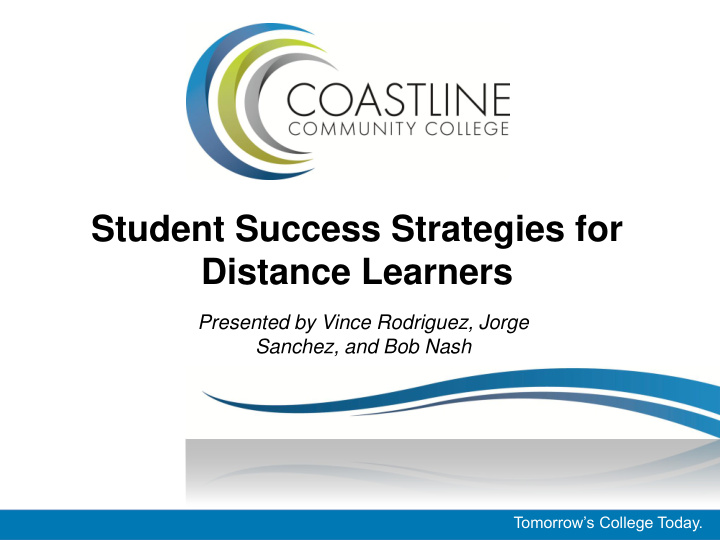



Student Success Strategies for Distance Learners Presented by Vince Rodriguez, Jorge Sanchez, and Bob Nash Tomorrow’s College Today.
1998-99 DL Enrollments = 12,513 2002-03 DL Enrollments = 20,405 Television Television 48% 77% Cable 3% Internet 40% CD-Rom 9% Cable CD-ROM 7% Internet 8% 8% 2006-07 DL Enrollments = 31,975 2009-10 DL Enrollments = 50,000+ Other 1% Television Television 21% 55% Internet 78% Internet Other 44% 1%
Coastline College: Fall 2008 Gender of DL Enrollments 90.0% 80.0% 70.0% 60.0% Percent 50.0% 40.0% 30.0% 20.0% 10.0% 0.0% Female Male Online 47.4% 52.6% TV 19.7% 80.3%
Coastline College: Fall 2008 Age of DL Enrollments by Mode of DL 4,500 Online TV 4,000 3,500 3,000 2,500 2,000 1,500 1,000 500 0 < 18 18 & 19 20 to 24 25 to 29 30 to 34 35 to 39 40 to 49 50 +
Coastline College: Fall 2008 Ethnicity of DL Enrollments 40.0% 30.0% Percent 20.0% 10.0% 0.0% Asian Black Hispanic White Unknown Online 10.1% 5.3% 13.4% 43.7% 14.8% TV 5.0% 22.8% 24.3% 31.3% 12.6%
Current Student Characteristics • Summer 2010 survey • Population of 3,200 online students • 25% response rate
1999 DL Student Success Survey • Random sample: 3,261 DL students from spring, summer & fall (32% of total population) • All modalities: Telecourse, Online & Independent study • 5% of population responded
Expectations/Reasons for Enrolling Key Results Conclusions • 66% said they enrolled in • Time and flexibility is DL “because of time or extremely valuable to physical constraints” these students • 48% said “I like learning • They may benefit from at my own pace” pre-course orientations that manage expectations • 10% admitted they and describe workload thought “the coursework would be a little easier”
Reasons for Drop/Failure Conclusions Key Results • They may benefit from • 40% said “I tried to pre-course orientations accomplish too much that about course schedule semester” -- especially and workload those who dropped • They may benefit by • 25% indicated, “I had student success courses difficulty managing my or seminars on time mgt. time” -- especially those & planning who failed
Tinto’s Model of Student Retention - Attrition Social Student Interaction Characteristics Goal Persist or Commitment Withdraw Family Academic Background Performance
Some Factors Related to DL Success & Failure Within our control Out of our control • Expectations • Lack of time • Services • Job Requirements • Success skills • Illness • Course performance • Life/Family Problems • Instructor support • Previous GPA • Peer interaction • Learning Style • Satisfaction
Some DL Student Success Strategies • Anticipate • Motivate • Communicate • Cultivate
Anticipate Needs & Questions Student Services • Online, self-directed Course Design • Quality rubric • Everything explained, FAQs
Motivate Participation & Involvement Encourage more time on task • Make learning relevant • Realistic, authentic tasks/skills • Problems, cases, stories Use media and technology that is both effective and cool
Communicate That You Care Make connections & build relationships • Maintain “presence” • Encourage interaction Reminding correspondence Prompt feedback on assignments
Cultivate Good Learners Manage expectations Look for opportunities to connect students to services, support Build self-directed, self- regulating students through JIT learning moments
Other DL Success Strategies • Intake DL “readiness” assessment • Early alert system • Online learning communities & linked courses • Interdisciplinary programs • Online Tutoring (for course assignments) • Peer Tutors/Mentors • Mandatory DL student success course • Integrated FYE program
References • Conrad & Donaldson, Engaging the Online Learner (Jossey- Bass) • Ko & Rossen, Teaching Online: A Practical Guide (Houghton Mifflin) • Palloff & Pratt, Building Learning Communities in Cyberspace (Jossey-Bass) • Nash, R. (2005) “Course completion rates among distance learners: identifying possible methods to improve retention.” Online Journal of Distance Learning Administration http://www.westga.edu/~distance/ojdla/winter84/nash84.htm
Contact Information • Vince Rodriguez, x16211, vrodriguez@coastline.edu • Jorge Sanchez, x16338, jsanchez@coastline.edu • Bob Nash, x17523, bnash@coastline.edu
Recommend
More recommend